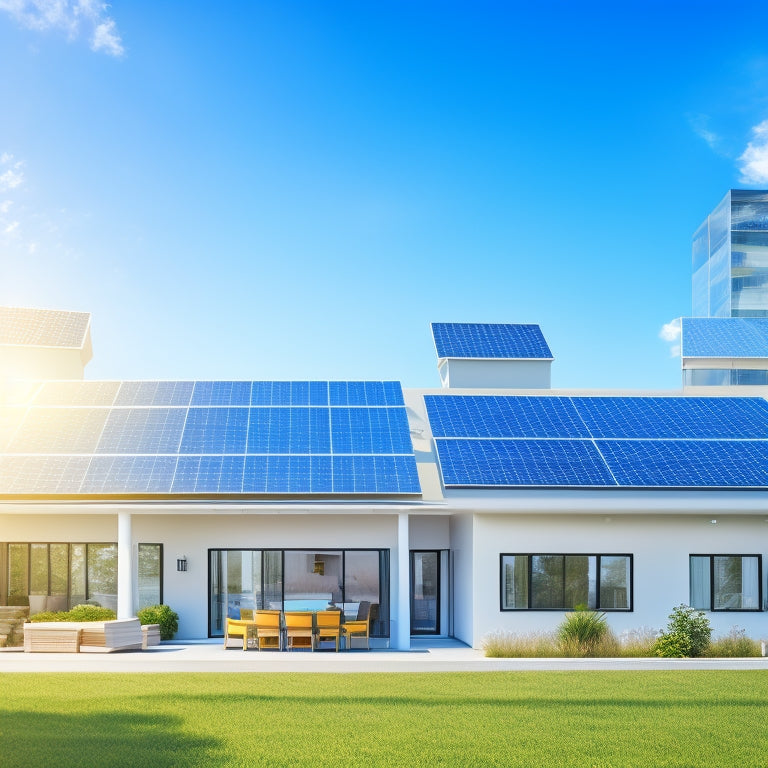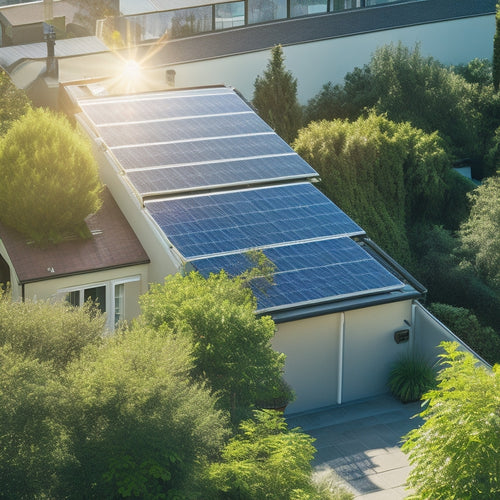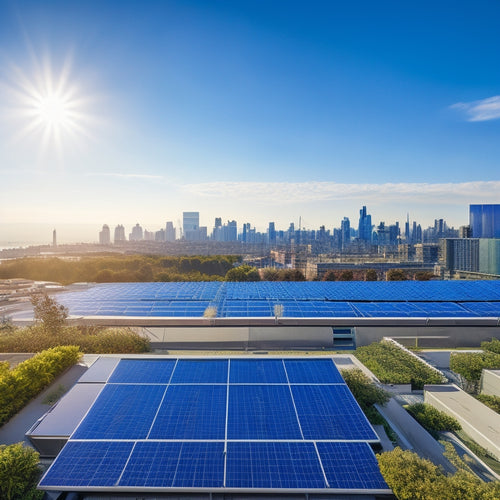
PV Panels Cost Pricing Options for Homes and Businesses
Share
When it comes to PV panels, cost pricing options vary for homes and businesses, depending on several factors. Equipment type and quality, installation company, local market trends, financing options, and permitting complexity all influence upfront costs. System size, determined by energy needs, also plays a major role, as larger systems cost more but produce more energy. Additionally, incentives like federal and state credits, as well as local rebates, can greatly reduce costs. As you maneuver through these factors, you'll want to contemplate the long-term benefits, including reduced energy bills, low maintenance costs, and increased property value - and that's just the beginning of your path to finding the right PV panel solution.
Key Takeaways
- The cost of PV panels varies based on equipment type and quality, installation company, local market trends, and financing options.
- System size and energy needs are crucial factors, with larger systems offering greater energy production but higher upfront costs.
- Installation complexity, labor costs, and local incentives significantly impact the overall cost of PV panel installations.
- Federal and state incentives, such as tax credits and rebates, can substantially reduce the upfront costs of PV panel installations.
- Long-term cost savings and benefits, including reduced energy bills, low maintenance costs, and increased property value, make PV panels a worthwhile investment.
Residential PV Panel Pricing
As you investigate residential PV panel pricing, you'll find that the cost of installing solar panels on your home can vary considerably depending on several factors. The type and quality of equipment, installation company, and local market trends all impact the final cost.
Financing options, such as loans or power purchase agreements, can also affect the upfront cost.
When considering residential PV panel pricing, it's vital to think about your home energy needs. Evaluating your energy usage and determining the ideal system size will help you optimize your investment.
Installation trends, such as roof-mounted or ground-mounted systems, can also influence the cost. Additionally, maintenance costs and grid connection fees should be factored into your overall budget.
Achieving energy independence and enjoying environmental benefits are significant advantages of solar power. Recent technology advancements have improved efficiency and reduced costs.
As market trends and consumer preferences continue to evolve, it's imperative to stay informed about the latest developments in residential PV panel pricing.
Commercial PV Panel Cost Factors
When pricing commercial PV panels, you'll need to take into account several key factors that impact the overall cost.
The size of the system is a significant consideration, as larger systems typically require more materials and labor.
Additionally, installation complexity and local incentives can also influence the final cost, making it essential to carefully evaluate these factors to get an accurate estimate.
System Size Matters
Your commercial PV panel cost factors greatly depend on the system size, which directly correlates with the overall project cost. A larger system typically means higher upfront costs, but it also translates to more energy production and potentially greater savings in the long run.
When considering system size, you'll want to think about your energy needs and goals. A smaller system may be suitable for offsetting a portion of your energy usage, while a larger system can provide more extensive coverage.
System efficiency also plays a significant role in determining the overall cost. A more efficient system will require fewer panels to produce the same amount of energy, which can reduce your upfront costs.
However, more efficient panels often come at a higher price point. You'll need to weigh the benefits of increased energy production against the added expense.
Ultimately, the right system size for you'll depend on your specific circumstances and priorities. By carefully considering your energy needs, system efficiency, and budget constraints, you can find a PV panel solution that meets your power requirements while keeping costs in check.
Installation Complexity
The complexity of the installation process is another vital factor influencing commercial PV panel costs. As you contemplate installing solar panels, you'll face installation challenges that can drive up costs.
Complexity factors include site assessment, which determines the feasibility of the installation, and equipment accessibility, which affects installation timeframes. Roof suitability and structural considerations also play a major role, as they impact the type of equipment needed and the installation process.
The permitting process can add complexity, as it requires compliance with local regulations and building codes. Technician training and safety protocols are also essential, as they guarantee a safe and efficient installation.
You'll need to take these factors into account when planning your installation, as they can greatly impact the overall cost. A more complex installation will require more time, resources, and proficiency, increasing the cost of your PV panel system.
Local Incentives Impact
As you traverse the commercial PV panel cost terrain, local incentives emerge as a crucial factor influencing the final bill. These incentives can greatly reduce the upfront cost of installing PV panels, making them more accessible to businesses and homeowners.
| Incentive Type | Description |
|---|---|
| Rebate Programs | Offers a one-time payment to offset installation costs |
| Tax Credits | Provides a percentage of the total cost as a credit against taxes owed |
| Community Programs | Local initiatives offering discounted rates or special financing |
Solar Panel Installation Costs
When you're considering solar panel installation costs, you'll find that the price tag varies considerably depending on the system size, equipment quality, and labor costs.
You'll need to factor in the complexity of the installation, as larger systems typically require more equipment and labor.
System Size Matters
Five kilowatts is a typical system size for residential solar panel installations, but yours might be smaller or larger depending on your energy needs and available roof space. The system size you choose will greatly influence your energy production, system efficiency, and environmental impact.
A larger system will generate more electricity, but it'll also increase your upfront costs. You'll need to weigh the benefits of energy independence against the higher financing costs.
However, a larger system can also lead to lower maintenance costs in the long run. Be certain to take warranty considerations and technology advancements into account when selecting your system size.
Additionally, you'll need to confirm your system is compatible with grid integration requirements. As you investigate your options, keep an eye on market trends and the potential for future upgrades.
Equipment Quality Varies
Your solar panel system's equipment quality will greatly impact its performance, and ultimately, your solar panel installation costs. You'll want to take into account the equipment efficiency, as high-quality panels can produce more energy per hour of sunlight. A reputable brand's equipment is more likely to provide a higher energy output and longer panel lifespan, typically 25 years or more.
Warranty coverage is also vital, as it can protect your investment in case the equipment fails. Look for brands that offer extensive warranties, ideally 25 years or more, to make certain you're covered in case of equipment failure.
Additionally, reflect on the maintenance requirements of the equipment, as some systems may require more frequent cleaning or repairs. The environmental impact of the equipment is another significant factor, as some manufacturers may have more sustainable practices than others.
Labor Costs Differ
How much will it cost to have a professional install your solar panel system? Labor costs greatly influence the overall installation price, and they vary depending on your location and the contractor you hire.
The labor market and regional differences play a considerable role in determining these costs. In areas with high job availability and a skilled workforce, labor costs tend to be lower. On the other hand, regions with stricter labor regulations and higher wage standards can drive up costs.
Installation training and contractor knowledge also influence labor costs. A contractor with extensive experience and certifications will typically charge more than a less-experienced installer.
Additionally, the complexity of the installation, such as roof type and system size, affects labor costs. It's crucial to research local contractors, compare quotes, and evaluate their proficiency to guarantee you're getting the best value for your money.
PV System Size and Price
A key determinant of PV panels cost is the system size, which directly impacts the overall price of the installation. When you're weighing investing in solar energy, you need to reflect on the size of the system you require. A larger system will naturally cost more, but it will also generate more electricity and provide greater investment returns.
Here are some key factors to weigh when determining the size of your PV system:
-
Your energy usage: How much electricity do you currently use, and how much do you want to offset with solar energy?
-
Your roof size and space: How much space do you have available for PV panels, and what's the size and shape of your roof?
-
Efficiency ratings: More efficient panels will require less space, but may be more expensive.
-
Grid connection: If you want to sell excess energy back to the grid, you'll need a larger system.
-
Energy independence: How much do you want to rely on solar energy, and how much do you want to reduce your reliance on the grid?
Federal and State Incentives
In addition to system size, federal and state incentives greatly influence PV panels cost, making solar energy a more attractive investment option. You can benefit from these incentives, which can considerably reduce the upfront cost of your solar panel system.
| Incentive Type | Description | Benefit |
|---|---|---|
| Federal Rebate | 26% tax credit of the total system cost | Up to 26% of total cost |
| State Credit | Varies by state, but typically a fixed amount per watt | $0.50 to $1.50 per watt |
| Net Metering | Utility credits for excess energy generated | Varies by utility company |
These incentives can add up quickly. For example, if you install a 10-kilowatt system that costs $30,000, you could be eligible for a federal rebate of $7,800 and a state credit of $5,000, bringing your total cost down to $17,200. Additionally, you'll earn credits from your utility company for any excess energy your system produces. By taking advantage of these incentives, you can considerably reduce the cost of your PV panel system and start generating clean energy sooner.
Long-Term Cost Savings Analysis
Several years of electricity savings can offset the initial investment in your PV panel system. Over time, you'll enjoy significant long-term cost savings, making your investment in solar energy a smart financial decision.
Some of the key benefits of going solar include:
-
Reduced energy bills: You'll generate your own clean energy and reduce your reliance on the grid, saving you money on your electricity bills.
-
Low maintenance costs: PV panels require minimal upkeep and are designed to last for decades, reducing maintenance costs and hassle.
-
Increased resale value: Installing a PV panel system can increase your property's value, making it more attractive to potential buyers.
-
Environmental benefits: By switching to solar, you'll reduce your carbon footprint and contribute to a cleaner, healthier environment.
-
Return on investment: With financing options available, you can start seeing a return on your investment in as little as 5-7 years, making solar a smart financial move.
With grid tie advantages, technology advancements, and market trends on your side, now is the perfect time to invest in PV panels and start enjoying the long-term cost savings they provide.
Frequently Asked Questions
Can I Install PV Panels on a Rented Property?
You'll need to obtain renter permissions and review your lease agreements before installing PV panels on a rented property, ensuring you're not violating any terms and can negotiate a mutually beneficial arrangement with your landlord.
Do Solar Panels Work During Power Outages?
You'll find that solar panels don't provide power during outages unless you have a battery storage system, which enables you to store excess energy generated during the day for use during power outages, ensuring uninterrupted solar panel functionality.
How Do I Clean and Maintain My Solar Panels?
You'll maximize your solar panels' efficiency by implementing effective cleaning techniques, such as gentle water rinsing and soft-bristle brushing, and following maintenance tips, like inspecting for debris and verifying secure connections, to guarantee peak power generation.
Can I Use PV Panels With a Septic System?
You can safely use PV panels with a septic system, as they don't interfere with each other; in fact, solar energy benefits include reducing your reliance on the grid, which can help lower your septic system's energy-dependent maintenance costs.
Are Solar Panels Covered by Homeowners' Insurance?
You're probably thinking solar panels are a risk, but ironically, they're a great investment - and your homeowners' insurance likely covers them! Check your policy for insurance coverage, understanding policy limitations, to guarantee you're protected in case of damage or theft.
Conclusion
As you stand at the crossroads of energy independence, the path to utilizing the sun's power beckons. Like an expert navigator charting a course through uncharted waters, you've examined the vast expanse of PV panel pricing options for homes and businesses. Now, armed with the knowledge of cost factors, installation costs, and incentives, you're ready to set sail towards a brighter, more sustainable future.
Related Posts
-

How Solar Panels Reduce Electricity Bills
Solar panels can drastically cut your electricity bills by utilizing sunlight to generate your own energy. This decre...
-

Evaluating Solar Power Options for Businesses
Evaluating solar power options for your business can greatly reduce energy costs and enhance sustainability. Start by...
-

Business Solar Investments for Cost-Effective Sustainability
Investing in solar energy is a smart move for your business, providing a solid foundation for cost-effective sustaina...


